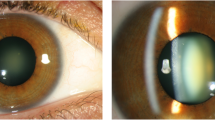Abstract
Background
Early vitrectomy for complete fundus-obscuring vitreous haemorrhage (VH) allows for prompt diagnosis and treatment of the cause.
Aims
To analyse the causes of VH of unknown aetiology, whether partially fundus-obscuring or dense, and to determine the outcomes of early vitrectomy.
Methods
A retrospective review of patients who underwent early vitrectomy within 10 days of symptom-onset for partially fundus-obscuring or dense VH of unknown origin. Patients with evidence of proliferative diabetic retinopathy in either eye or any other preoperatively diagnosed aetiology of VH were excluded.
Results
19 patients were included. Intraoperative diagnoses were: retinal tears without rhegmatogenous retinal detachment (RRD) (53%); peripheral localised RRD (32%); neovascularisation secondary to retinal vein occlusion (11%) and posterior vitreous detachment without a retinal break (5%). Patients with diffuse VH were as likely to have a retinal tear diagnosed as those with dense VH (88% vs 82%, respectively; p = 0.7). Mean VA improved from 1.26 LogMAR to 0.23 LogMAR postoperatively (p = 0.001). 1 patient (5%) developed a RRD one-year postoperatively.
Conclusions
In cases of diffuse or dense VH of unknown aetiology, an occult retinal tear should be suspected. Early vitrectomy should be strongly considered regardless of whether the fundal view is partially or completely obscured, to prevent progression to visually significant RRDs.
Similar content being viewed by others
Data availability
Data will be available from the corresponding author upon reasonable request.
References
Lindgren G, Sjödell L, Lindblom B (1995) A prospective study of dense spontaneous vitreous hemorrhage. Am J Ophthalmol 119:458–465. https://doi.org/10.1016/s0002-9394(14)71232-2
Spraul CW, Grossniklaus HE (1997) Vitreous hemorrhage. Surv Ophthalmol 42:3–39. https://doi.org/10.1016/s0039-6257(97)84041-6
Dhingra N, Pearce I, Wong D (2007) Early vitrectomy for fundus-obscuring dense vitreous haemorrhage from presumptive retinal tears. Graefes Arch Clin Exp Ophthalmol 245:301–304. https://doi.org/10.1007/s00417-006-0278-6
Tan HS, Mura M, Bijl HM (2010) Early vitrectomy for vitreous hemorrhage associated with retinal tears. Am J Ophthalmol 150:529–533. https://doi.org/10.1016/j.ajo.2010.04.005
Zhang T, Zhang J, Sun X et al (2017) Early vitrectomy for dense vitreous hemorrhage in adults with non-traumatic and non-diabetic retinopathy. J Int Med Res 45:2065–2071. https://doi.org/10.1177/0300060517708942
Connors D, Shah G, Blinder K, Dang S (2018) Early versus delayed vitrectomy for nondiabetic vitreous hemorrhage. J Vitreoretin Dis 2:87–90. https://doi.org/10.1177/2474126418758771
Hayashida M, Miki A, Imai H et al (2019) Impact of early vitrectomy for dense vitreous hemorrhage of unknown etiology. Ophthalmologica 242:234–238. https://doi.org/10.1159/000501723
Day AC, Donachie PH, Sparrow JM, Johnston RL (2015) The Royal College of Ophthalmologists’ National Ophthalmology Database study of cataract surgery: report 1, visual outcomes and complications. Eye (Lond) 29:552–560. https://doi.org/10.1038/eye.2015.3
Holden BA, Fricke TR, Wilson DA et al (2016) Global prevalence of myopia and high myopia and temporal trends from 2000 through 2050. Ophthalmology 123:1036–1042. https://doi.org/10.1016/j.ophtha.2016.01.006
Kolar P (2014) Risk factors for central and branch retinal vein occlusion: a meta-analysis of published clinical data. J Ophthalmol 2014:724780. https://doi.org/10.1155/2014/724780
Rabinowitz R, Yagev R, Shoham A, Lifshitz T (2004) Comparison between clinical and ultrasound findings in patients with vitreous hemorrhage. Eye (Lond) 18:253–256. https://doi.org/10.1038/sj.eye.6700632
DiBernardo C, Blodi B, Byrne SF (1992) Echographic evaluation of retinal tears in patients with spontaneous vitreous hemorrhage. Arch Ophthalmol 110:511–514. https://doi.org/10.1001/archopht.1992.01080160089038
Sandinha MT, Kotagiri AK, Owen RI et al (2017) Accuracy of B-scan ultrasonography in acute fundus obscuring vitreous hemorrhage using a standardized scanning protocol and a dedicated ophthalmic ultrasonographer. Clin Ophthalmol 11:1365–1370. https://doi.org/10.2147/opth.S133938
Sarrafizadeh R, Hassan TS, Ruby AJ et al (2001) Incidence of retinal detachment and visual outcome in eyes presenting with posterior vitreous separation and dense fundus-obscuring vitreous hemorrhage. Ophthalmology 108:2273–2278. https://doi.org/10.1016/s0161-6420(01)00822-3
Melamud A, Pham H, Stoumbos Z (2015) Early vitrectomy for spontaneous, fundus-obscuring vitreous hemorrhage. Am J Ophthalmol 160:1073-1077.e1071. https://doi.org/10.1016/j.ajo.2015.07.025
Neffendorf JE, Gupta B, Williamson TH (2017) Intraoperative complications of patients undergoing small-gauge and 20-gauge vitrectomy: a database study of 4,274 procedures. Eur J Ophthalmol 27:226–230. https://doi.org/10.5301/ejo.5000856
Funding
We did not receive funding for this research.
Author information
Authors and Affiliations
Contributions
M.M.O’R. designed the study, collected, and analysed data, and wrote the manuscript. G.A.M. collected data and made critical revisions to the manuscript. K.P.K. performed the vitrectomies, designed the study, and made critical revisions to the manuscript. All authors have read and agreed to the published version of the manuscript.
Corresponding author
Ethics declarations
Ethics approval
This study adhered to the tenets of the Declaration of Helsinki. The study protocol was reviewed and approved by the Research Ethics Committee of the University of Limerick Hospitals Group, with the registration number 137/2022. Informed consent was waived as this is a retrospective study.
Conflict of interest
The authors have no conflicts of interest to declare.
Additional information
Publisher's Note
Springer Nature remains neutral with regard to jurisdictional claims in published maps and institutional affiliations.
Rights and permissions
Springer Nature or its licensor (e.g. a society or other partner) holds exclusive rights to this article under a publishing agreement with the author(s) or other rightsholder(s); author self-archiving of the accepted manuscript version of this article is solely governed by the terms of such publishing agreement and applicable law.
About this article
Cite this article
O’Riordan, M.M., McCabe, G.A. & Kennelly, K.P. Early vitrectomy is indicated for both diffuse and dense vitreous haemorrhages of unknown aetiology. Ir J Med Sci (2023). https://doi.org/10.1007/s11845-023-03573-6
Received:
Accepted:
Published:
DOI: https://doi.org/10.1007/s11845-023-03573-6




